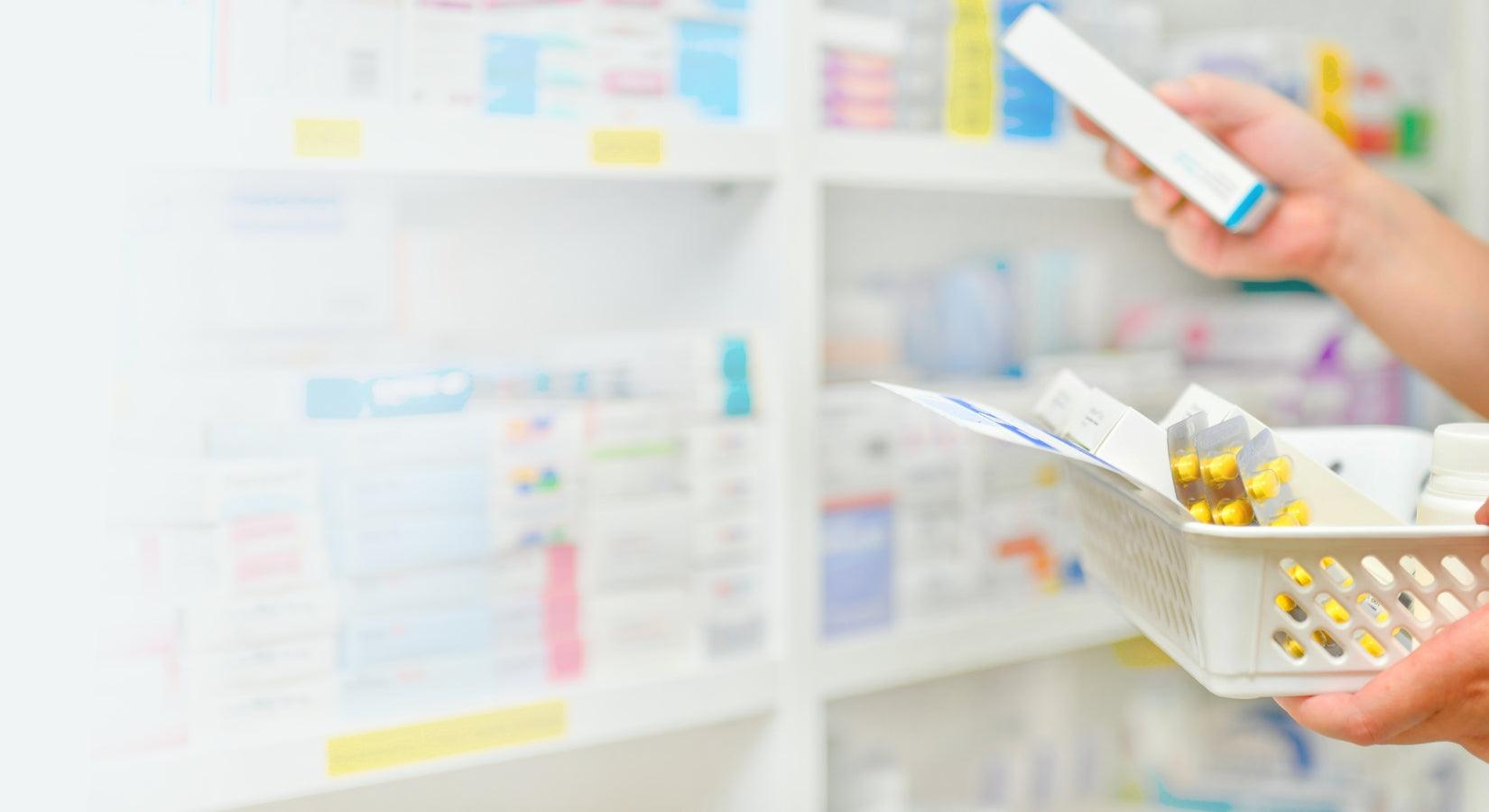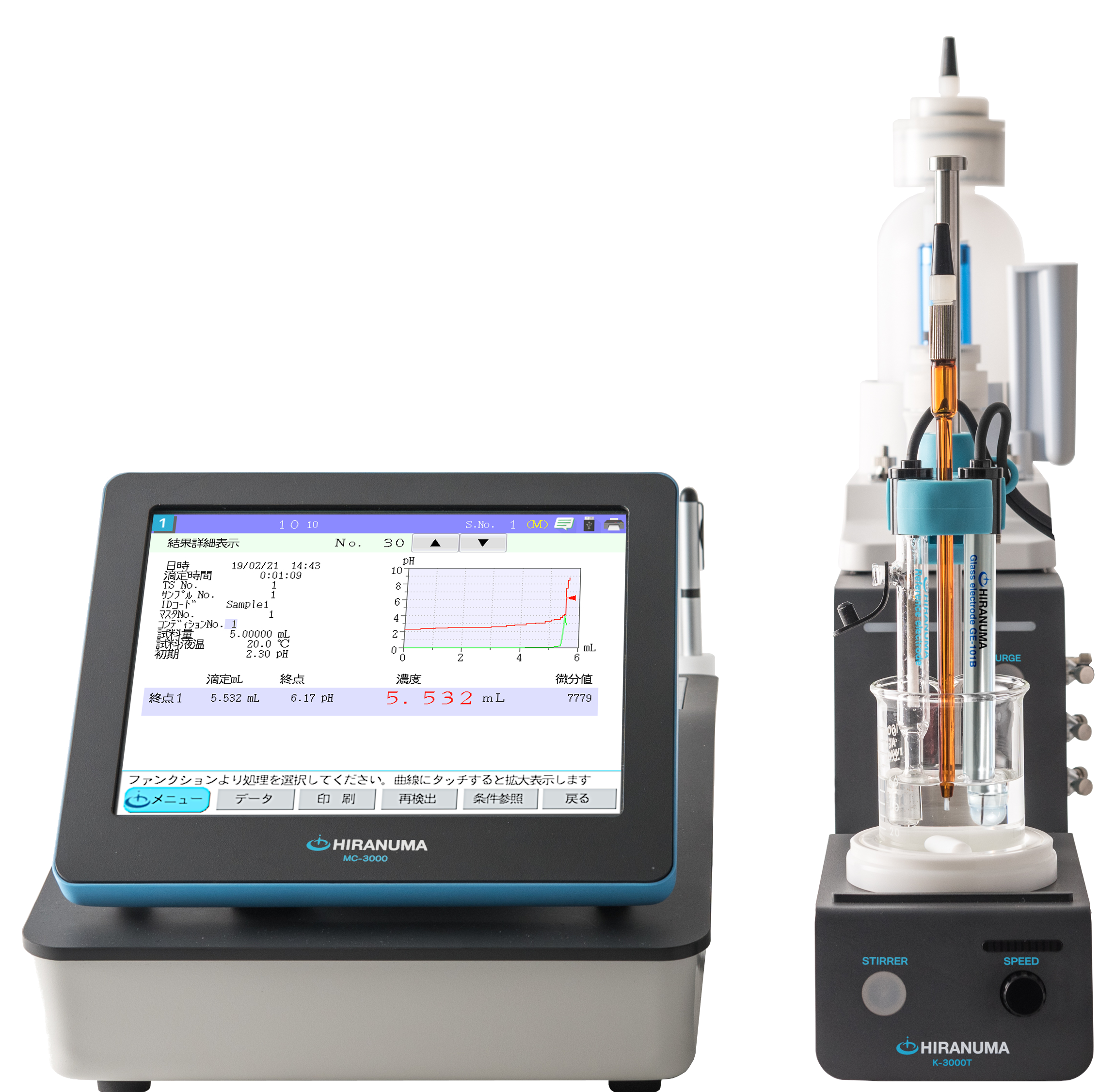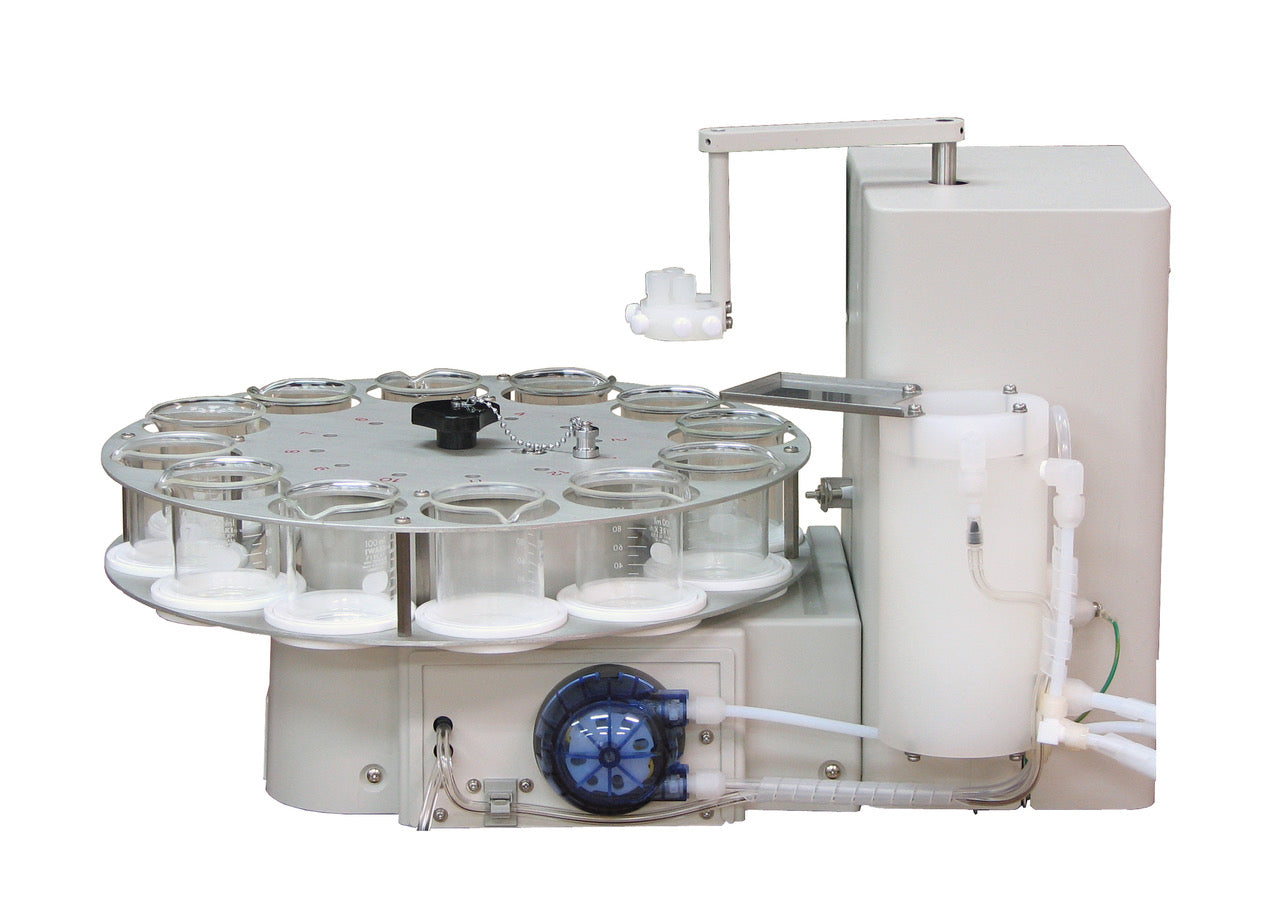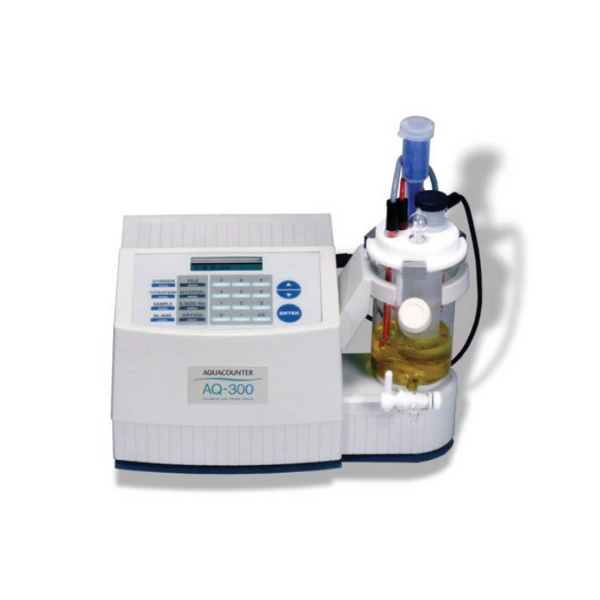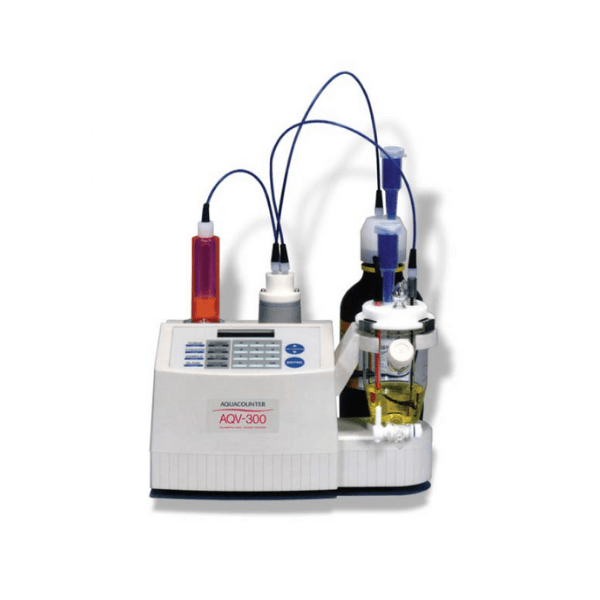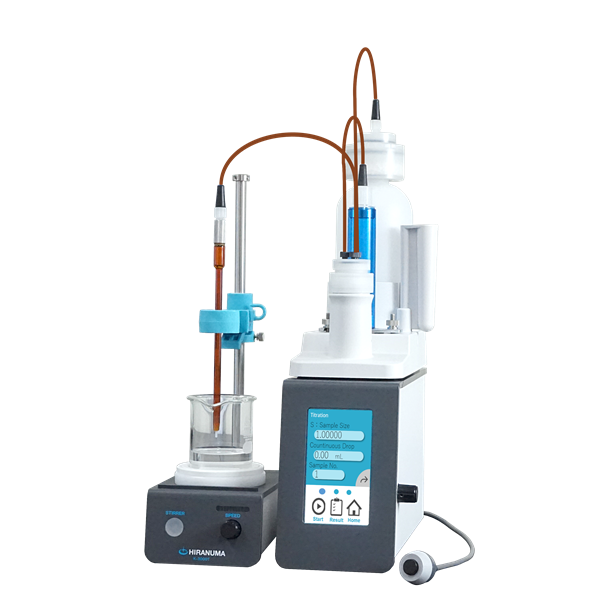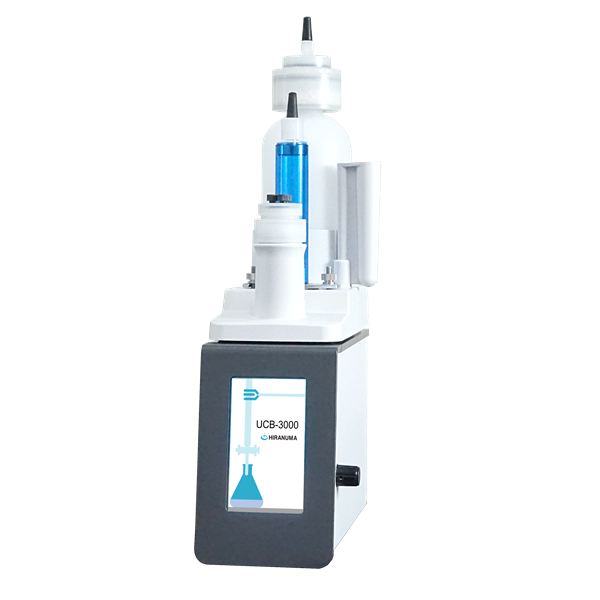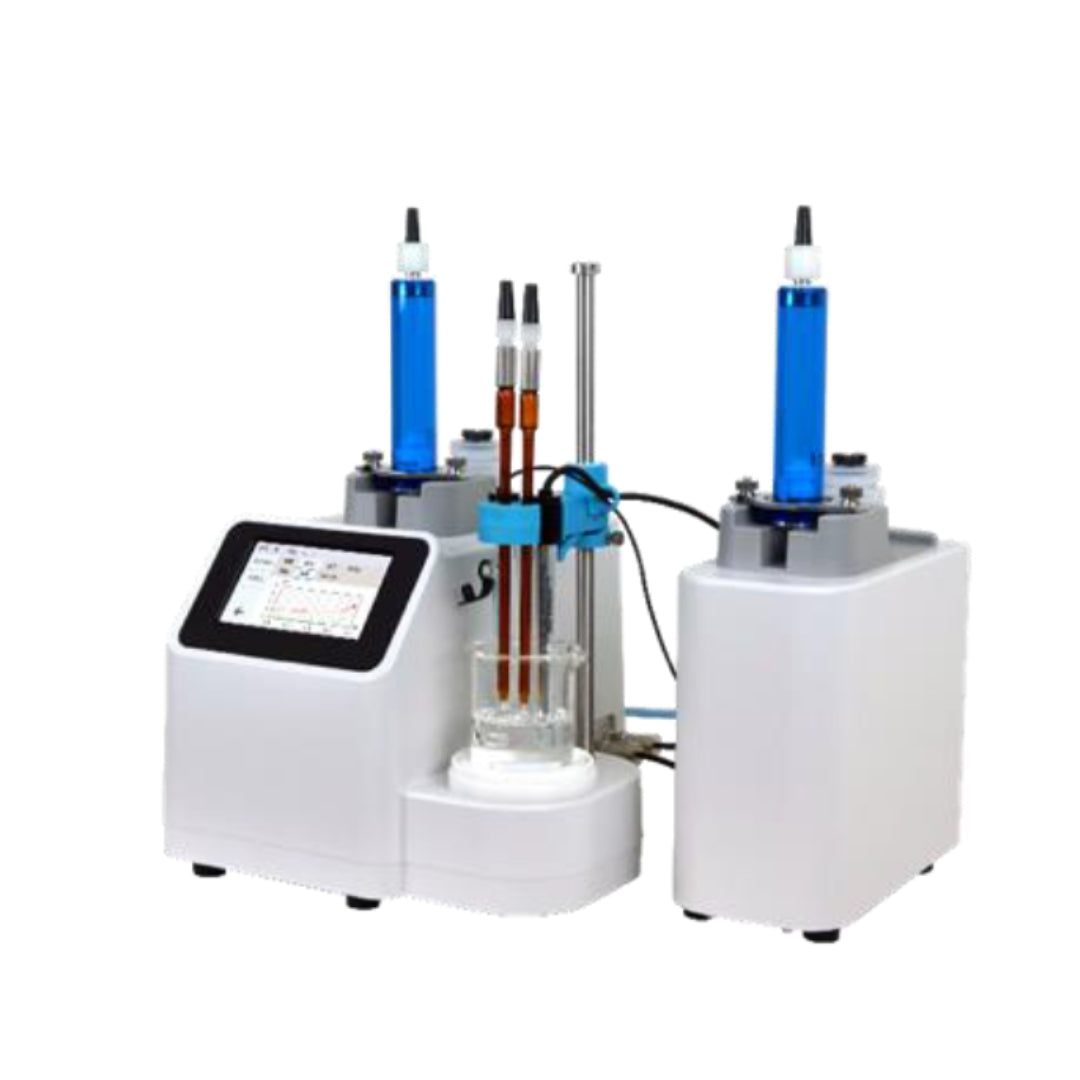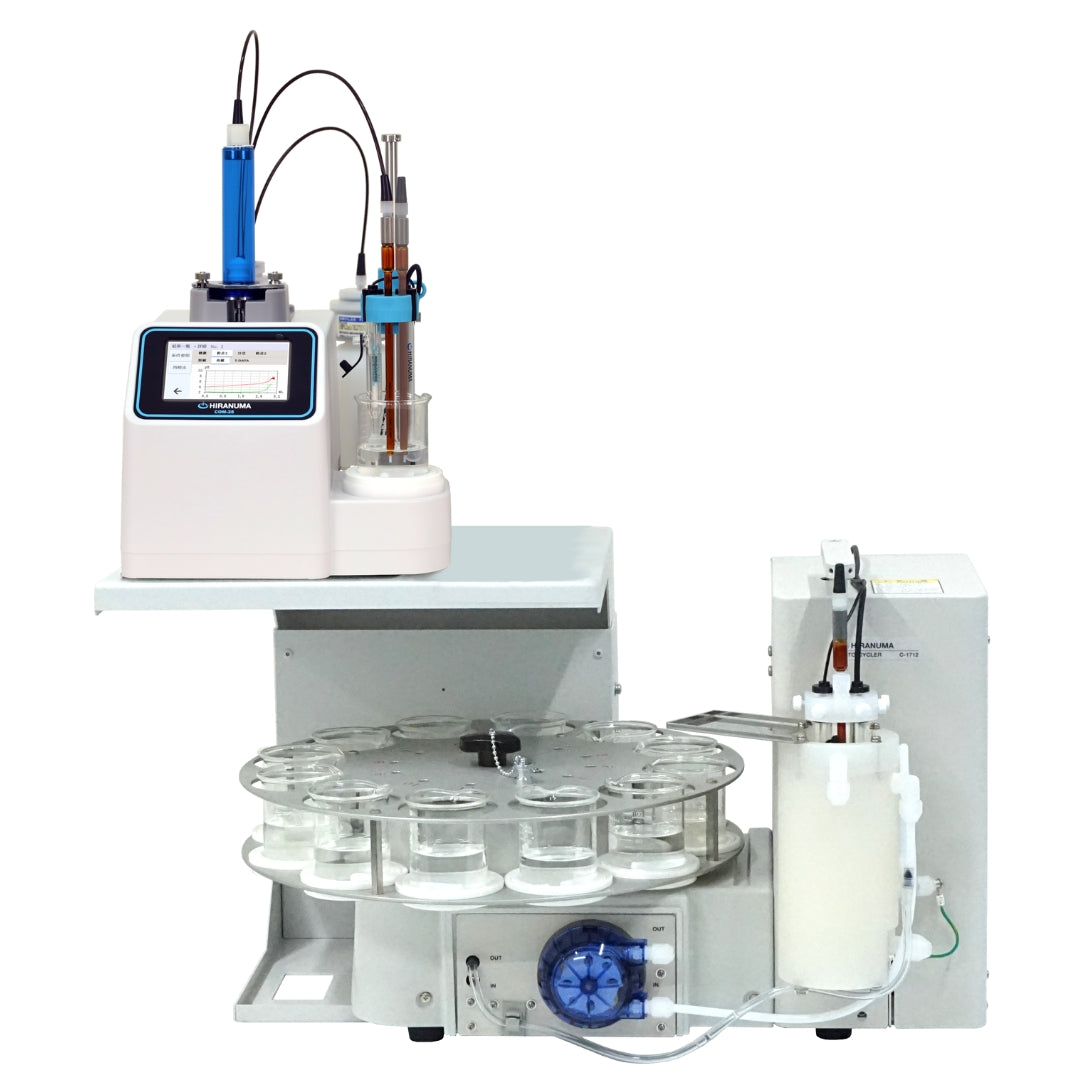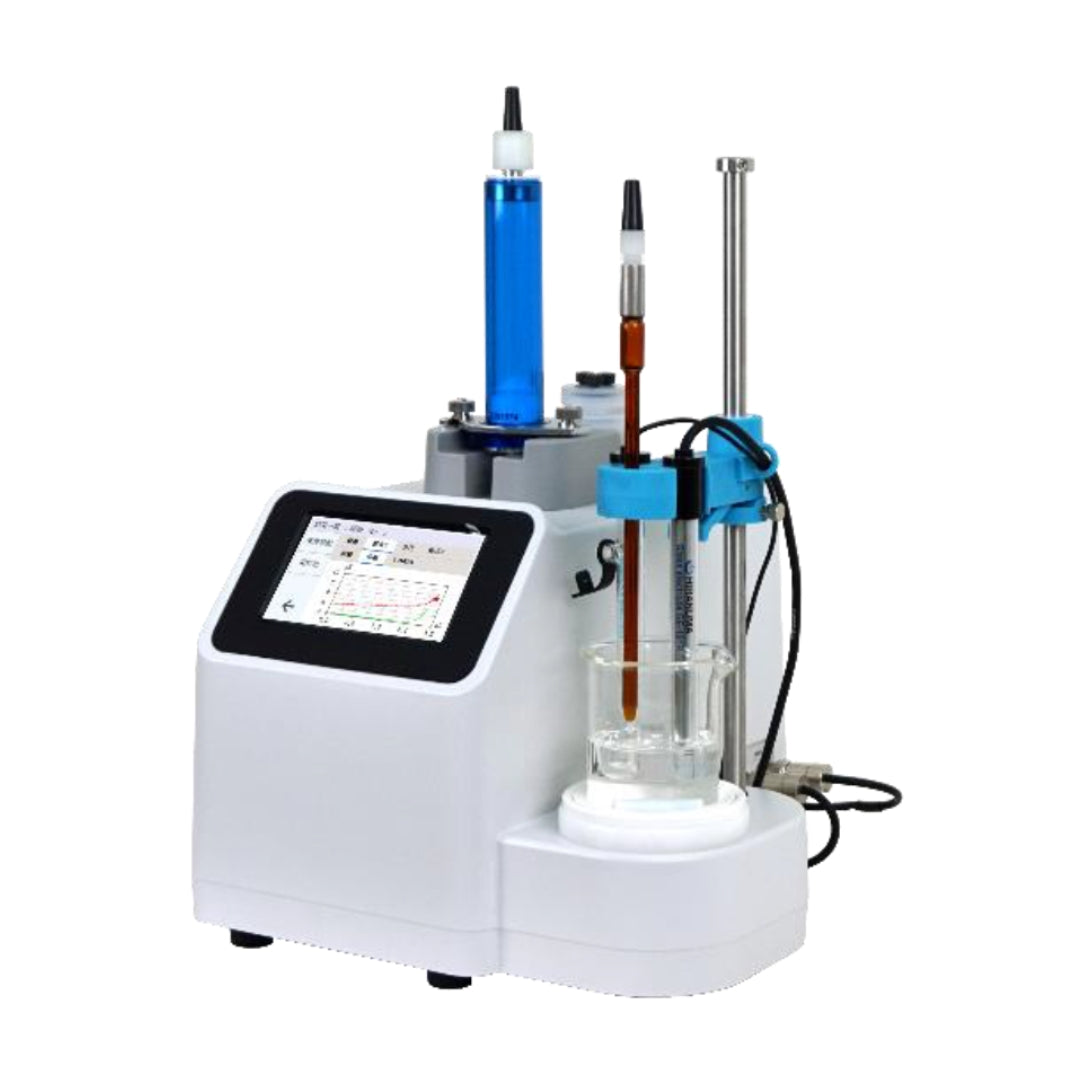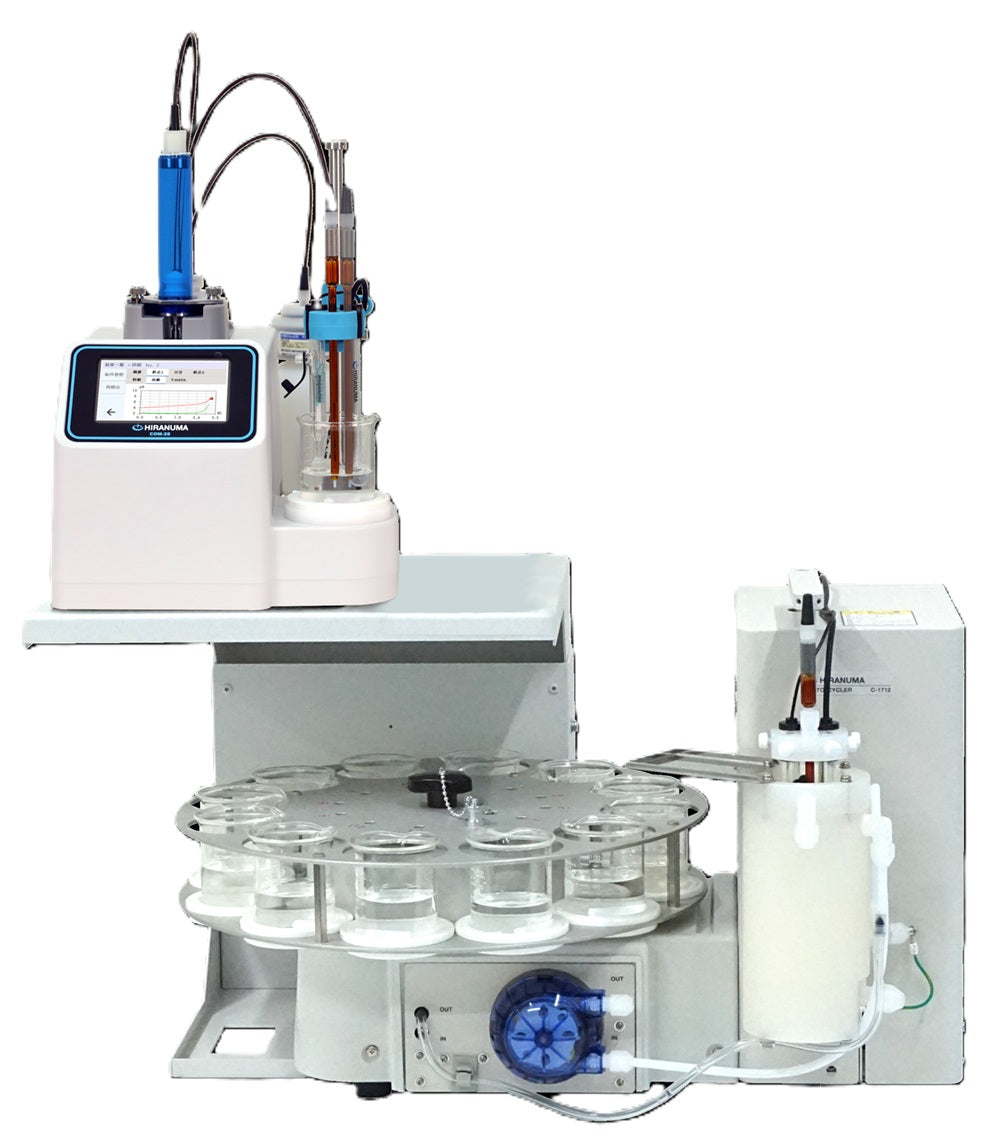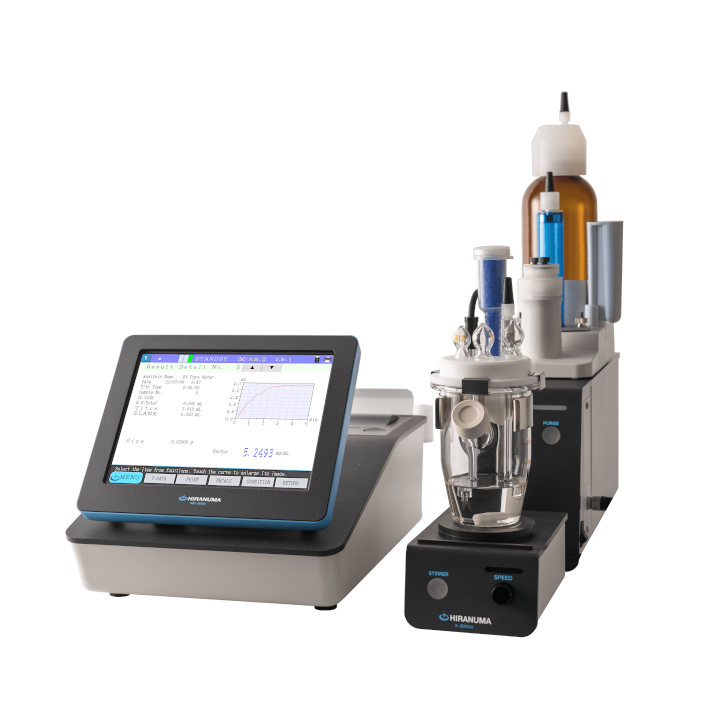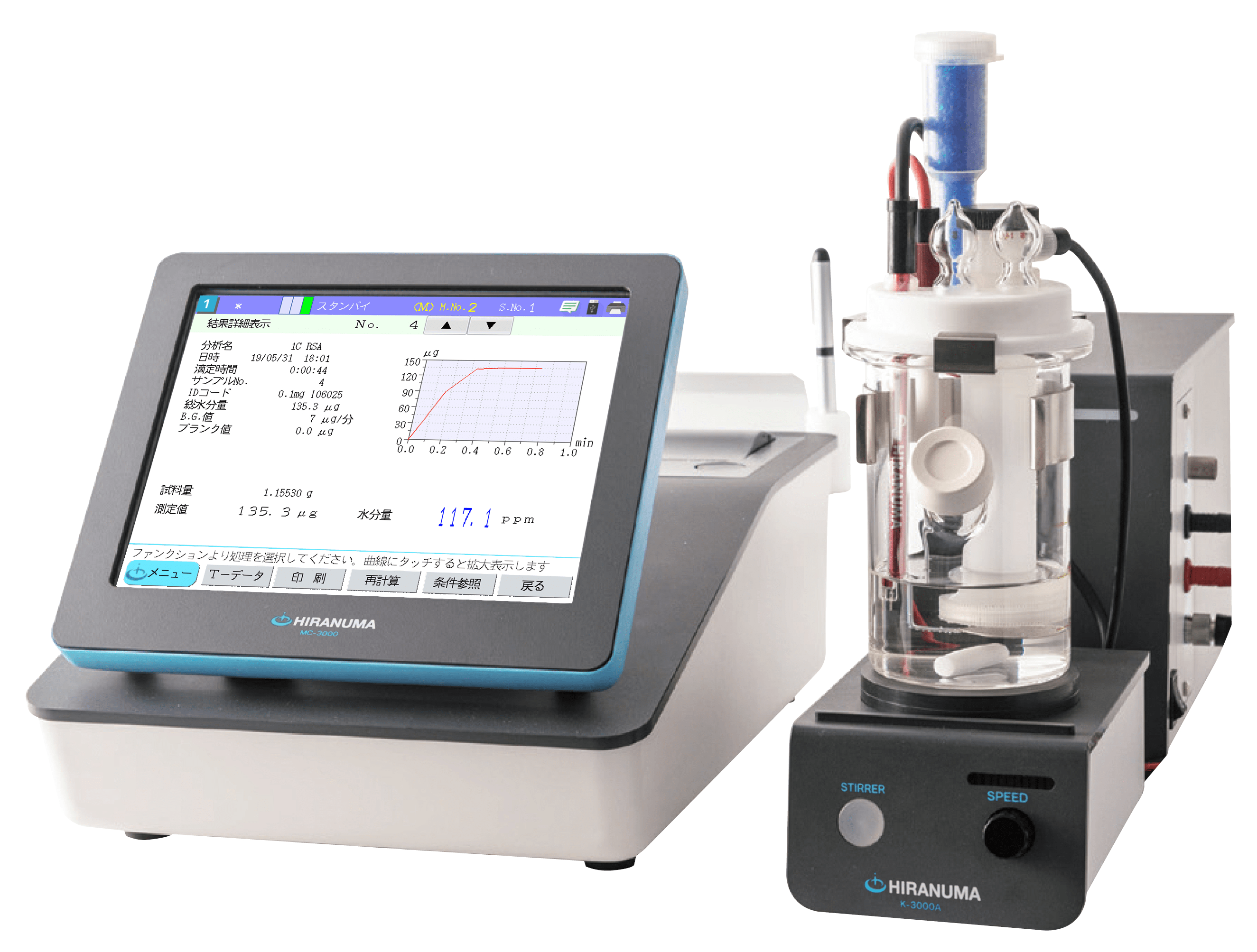| HIRANUMA APPLICATION DATA | Karl Fischer Titrator | Data No. | KF20 | Apr. 13, 2022 |
| Water contents | Drugs and Medicines – KF Volumetry Japanese Pharmacopoeia – Suitability test |
1. Abstract
Water contents of drugs and medicines could be determined by Karl Fischer volumetric titrator. In volumetric titration, the titrant have a factor which means the ability to react with how many milligrams of water per 1 mL of titrant. Factor is pre-determined before sample measurement and water content of sample is calculated from consumed titrant volume within sample measurement.
In the method of “Water determination (Karl Fischer method)” in Japanese Pharmacopoeia Eighteenth Edition, the suitability test is described as a verification procedure when modifying the test procedures. In this report, a case example of suitability test is introduced with using glycerin as a simulated measurement sample.
Reference
1) Japanese Pharmacopoeia Eighteenth Edition
2. Apparatus and Reagents
| (1) | Apparatus | ||
| Titrator | : | HIRANUMA Karl Fischer Volumetric titrator AQV-series or MOIVO-A19 | |
| Titration cell | : | Standard cell | |
| Sampler | : | Syringe | |
| (2) | Reagents | ||
| KF Titrant | : | AQUALYTE KF3 (HIRANUMA) An alternative if it is difficult to prepare, HYDRANAL Composit 5 (Honeywell) |
|
| Titration solvent | : | HYDRANAL Methanol Dry (Honeywell) | |
| (3) | Sample | ||
| Measurement sample | : | Glycerin (Guaranteed reagent) | |
| Standard material | : | AQUALYTE Water Standard 10 (Assay: 10.01 mg/g, HIRANUMA) An alternative if it is difficult to prepare, HYDRANAL Water Standard 10 (Honeywell) |
3. Procedure
3.1. Factor determination of KF titrant
| (1) | Fill 50 mL of titration solvent into the titration cell as shown in Fig.3.1. |
| (2) | Start blanking to attain stable background. |
| (3) | Draw DI water into syringe. And then weigh it and record its read (Size 1 [g]). |
| (4) | Inject a few drops of water from rubber septum of titration cell as shown in Fig.3.2. Approximate amount of addition is 20-40 mg. (40-60 mg when using Composite 5 for KF titrant) |
| (5) | Start titration. Measurement parameter is shown in Table 4.1. |
| (6) | Weigh the syringe again and record its read (Size 2 [g]). The difference of (Size 1-Size 2 [g]) is set as sample size. |
| (7) | Repeat the measurement 3 times and obtain an average value for factor of KF titrant. * The above sampling procedure is an example for a simulated sample. It should be performed according to the actual sample and the suitability test to be implemented. |

Fig.3.1 Preparation of the titration solvent

Fig.3.2 Injection of sample
3.2. Procedure for suitability test
| (1) | Fill 50 mL of titration solvent into the titration cell as shown in Fig.3.1. |
| (2) | Start blanking to attain stable background. |
| (3) | Wash the syringe with the sample of glycerin and draw it into syringe. Then, weigh the syringe and record its read (Size 1 [g]). |
| (4) | Inject the sample from rubber septum of titration cell as shown in Fig.3.2. The injection amount is adjusted so that the detected water (mg) is within 5 to 30 mgH2O. |
| (5) | Start titration. Measurement parameter is shown in Table 4.2. |
| (6) | Weigh the syringe again and record its read (Size 2 [g]). The difference of (Size 1-Size 2 [g]) is set as sample size. |
| (7) | After measurement of the sample is finished, the device, setting parameters, and reagents are used without change, and the water standard is measured subsequently. Wash the syringe with the water standard and draw it into syringe. Then, weigh the syringe and record its read (Size 1 [g]). |
| (8) | Inject the water standard from rubber septum of titration cell as shown in Fig.3.2. The injection amount is adjusted so that the detected water (mg) is 50 to 100 % of that of the sample measurement. Weigh the syringe again (Size 2 [g]). The difference of (Size 1-Size 2 [g]) is set as sample size. |
| (9) | Repeat the measurement of the water standard 5 times. * The above sampling procedure is an example for a simulated sample. It should be performed according to the actual procedure of the suitability test to be implemented with actual sample. |
3.3 Analysis of suitability test result
| (1) | Prepare the value required for analysis from measurement result. |
| M :Determined water in the sample measurement result (mgH2O) ⇒ Initial water content determined for sample of glycerin (mgH2O) |
|
| M1-x :Amount of added water in the water standard measurement (mgH2O), “X” indicates the number of water standard measurement ⇒ Amount of added water (mgH2O) |
|
| M2-x :Amount of found water in the water standard measurement result (mgH2O), “X” indicates the number of water standard measurement ⇒ Amount of found water (mgH2O) |
|
| (2) | Plot as follows using spreadsheet software. |
 |
|
| (3) | Create a regression line for the plots and find the following values. |
| b : Slope of regression line | |
| a : y-axis intercept | |
| d : x-axis intercept | |
| (4) | The percentage errors e1 (%) and e2 (%) are calculated from the following formulae. |
| e1 = {(a-M)/M} × 100 | |
| e2 = {(|d|-M)/M} × 100 | |
| (5) | From the following formula, calculate the water recovery rate r (%) for each of the 5 measurements of the water standard, and calculate the average water recovery rate R (%). |
| r (%) = (M2-X/M1-X) × 100 |
4. Parameters and results
Table 4.1 Parameters for factor measurement of KF titrant
| Item | ||
| Cal Mode | 7:KF Factor | |
| (By Pure water) | ||
| Interval Time | 30 | sec |
| Max Volume | 20 | mL |
| Min Feed Vol. | 0.01 | mL |
| S.Timer | 0 | min |
| KF Buret No. | 1 | |
| Item | ||
| KF Speed(OUT) | 24 | mL/min |
| KF Speed(IN) | 24 | mL/min |
| Back Ground | ON | |
| Sample Size Input | Every Time | |
| Blank Value | 0 | mL |
| E.P Detection | uA | |
| Solvent | S,O,CE | |
| C.P Level | 150 | uA |
| E.P Level | 200 | uA |
| Auto Interval | 0 | g |
| Auto Input | OFF |
Table 4.2 Parameters for sample measurement
| Item | ||
| Cal Mode | 0:Sample weight (net) | |
| Interval Time | 30 | sec |
| Max Volume | 20 | mL |
| Min Feed Vol. | 0.01 | mL |
| S.Timer | 0 | min |
| KF Factor | 3.3917 | mg/mL |
| KF Buret No. | 1 | |
| Item | ||
| KF Speed(OUT) | 24 | mL/min |
| KF Speed(IN) | 24 | mL/min |
| Back Ground | ON | |
| Sample Size Input | Every Time | |
| Blank Value | 0 | mL |
| Unit Mode | AUTO | mL |
| E.P Detection | uA | |
| Solvent | S,O,CE | |
| C.P Level | 150 | uA |
| E.P Level | 200 | uA |
| Auto Interval | 0 | g |
* The above parameter settings are examples for a simulated sample. They should be set according to the parameters for suitability test to be implemented with actual sample.
Table 4.3 Results of factor measurement of KF titrant
| Sample | Meas. No. |
Sample size (g) |
Titrant volume (mL) |
KF factor (mg/mL) |
Statistics result | |
| Water | 1 | 0.0269 | 7.92 | 3.3995 | Avg. | 3.3917 mg/mL |
| 2 | 0.0297 | 8.81 | 3.3735 | SD | 0.0158 mg/mL | |
| 3 | 0.0321 | 9.44 | 3.4022 | RSD | 0.47 % | |

Fig.4.1 Measurement result of the sample

Fig.4.2 Example of measurement results of the water standard
Table 4.4 Values used for regression line of suitability test
| Sample | Meas. No. |
Sample size (g) |
Added water M1-x (mgH2O) |
Found water M2-x (mgH2O) |
x-axis Cumulative added water (mgH2O) |
y-axis M + Cumulative found water (mgH2O) |
percentage recovery r(%) |
| Sample | 1 | 7.1459 | – | 8.662 | – | – | – |
| Water | 1 | 0.6588 | 6.595 | 6.566 | 6.595 | 15.228 | 99.57 |
| Standard | 2 | 0.7001 | 7.008 | 6.994 | 13.603 | 22.222 | 99.80 |
| 3 | 0.6728 | 6.735 | 6.651 | 20.337 | 28.873 | 98.76 | |
| 4 | 0.6680 | 6.687 | 6.624 | 27.024 | 35.497 | 99.06 | |
| 5 | 0.7204 | 7.211 | 7.136 | 34.235 | 42.633 | 98.96 |

Fig.4.3 Result of calculated regression line
Table 4.5 Result of suitability test for Japanese Pharmacopoeia
| Item | Result | Standard | Compliant | |
| Found water of sample M (mgH2O) | 8.662 | 5~30 mgH2O | OK | |
| Average percent recovery R (%) | 99.23 | 97.5~102.5 % | OK | |
| y-axis intercept a (mgH2O) | 8.715 | – | – | – |
| Slope of regression line b | 0.991 | 0.975~1.025 | OK | |
| x-axis intercept d (mgH2O) | -8.794 | – | – | |
| Percentage error |e1| (%) | 0.61 | 2.5 % or less | OK | |
| Percentage error |e2| (%) | 1.52 | 2.5 % or less | OK |
5. Note
According to the Japanese Pharmacopoeia Eighteenth Edition, the suitability test is implemented for the verification when the procedures of sample measurement are changed. Please check the latest version of Japanese Pharmacopoeia before conducting the suitability test.
The condition parameters set in the device and the procedure of sample addition used in this report are examples for simulated samples. Adapt these to the actual sample to be verified by the suitability test.
Even if the sample, parameters, and sample addition method are different, the analysis procedure of suitability test can be performed in the same way.
In addition, from the Eighteenth Edition of Japanese Pharmacopoeia, the suitability test was adopted and the specific description on the preparation of Karl Fischer reagent was deleted. The purpose of this is as follows; as premises for complying the suitability test, it is possible to select and use the appropriate KF reagent from commercially available products, considering the solubility and interfering reaction according to the properties of the measurement sample.
| Keywords: | Karl Fischer, Volumetric titration, Japanese Pharmacopeia, Suitability test |

